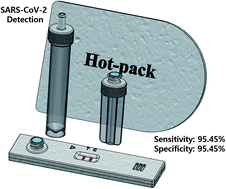Clinical evaluation of an innovative isothermal amplification detection system for COVID-19 diagnosis†
Abstract
A pre-integrated system design intended for a point-of-care (POC) and sample-to-result diagnostic platform with nucleic acid amplification has been developed, which is equipment/electricity-free without any permanent instruments or manual sample processing. This semi-integrated system focuses on pandemic situations that are suitable for the Affordable, Sensitive, Specific, User-friendly, Robust and rapid, Equipment-free, and Deliverable to the end-user “ASSURED” concept recommended by the World Health Organization (WHO). Nucleic acid amplification is an essential rate-limiting factor in the performance of integrated systems that involve sample preparation and detection. The ORF1ab (RdRp) gene of severe acute respiratory syndrome coronavirus 2 (SARS-CoV-2) has been targeted by RT-LAMP optimization and evaluation using a commercial hot-pack as a heat source that successfully achieves a femto-scale (<6.8 × 102 copies per rxn) limit of detection (LOD) within 40 min (except for the RNA extraction step). Therefore, the prototype system was assessed using COVID-19-suspected clinical samples (eighty eight) and compared with the results of a commercial real-time reverse transcription polymerase chain reaction (RT-qPCR) assay (Allplex SARS-CoV-2 Assay kit (Seegene, Seoul, Republic of Korea)). These innovative approaches achieved over 95% sensitivity and specificity. In conclusion, the developed system using a hot-pack as a heat source is a promising tool that enables the rapid identification of infectious diseases in the real world.

- This article is part of the themed collection: Analytical Methods HOT Articles 2022


 Please wait while we load your content...
Please wait while we load your content...